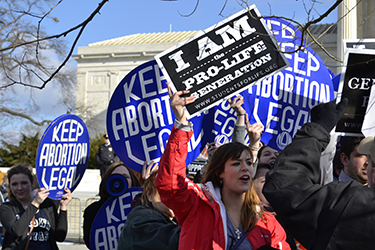Seventeen months after the U.S. Supreme Court overturned Roe v. Wade, resulting in the end to the federal constitutional right of abortion, many states have banned or restricted the practice.
At a Wednesday session, researchers at Indiana University’s Developing and Assessing Measures for Social Surveys team, part of the Indiana University Abortion Attitudes Project, discussed their multi-year work. The researchers are assessing popular surveys, conducting their own surveys and developing new survey questions, which may be more precise in learning about people’s abortion views. Eventually, the new questions may be used by large survey firms.
 In the session “Exploring People’s Attitudes and Knowledge before and after the Dobbs Decision,” the researchers presented the work with no conclusions or recommendations. But the data so far are revealing some broad misconceptions about public opinion that abortion rights advocates might use in the future to sharpen communication, messaging and policy advocacy.
In the session “Exploring People’s Attitudes and Knowledge before and after the Dobbs Decision,” the researchers presented the work with no conclusions or recommendations. But the data so far are revealing some broad misconceptions about public opinion that abortion rights advocates might use in the future to sharpen communication, messaging and policy advocacy.
Lucrecia Mena-Meléndez, assistant researcher on the surveys team, presented on a survey conducted post-Dobbs. Among the findings were that people concerned about when heartbeat in a fetus begins are more likely to oppose abortion, while people knowledgeable about abortion’s safety in the first trimester are likely to support choice.
In a qualitative study of 24 participants, conducted pre-Dobbs, researchers found that major indicators of abortion views involve religious beliefs, personal experiences, perceived social norms and moral correctness.
Results showed the complexity of their views. For example, while people with deep religious beliefs tended to be anti-abortion, some still sided with choice. A male participant distinguished between his morals and what he thought the ethical position should be.
“Even though I think it’s wrong, I do think it is a woman’s right to choose to do that,” he said.
Jaclyn Hadfield, a postdoctoral fellow at Indiana University’s School of Public Health, alluded to some media’s tendency to portray people on both sides of the abortion aisle as caricatures, which can affect messaging.
Hadfield suggested there may be more wiggle room for change among abortion supporters, saying that, unfortunately, “abortion is often described in the popular press as a contentious issue with few points of compromise or openness.”
Another finding in the research impugns a common notion among abortion right advocates: that state abortion laws don’t reflect the will of the people.
There is evidence for the common view. This month, Ohio voters approved an amendment to add abortion access to its constitution, becoming the seventh state to protect abortion access in the post-Dobbs era. Voters essentially rejected earlier efforts by Ohio’s conservative politicians to make constitutional changes targeting abortion rights. Last year, Kansas and Kentucky voted against constitutional amendments that opposed abortion rights.
Still, the will of the people and government may be more closely aligned than abortion rights advocates think. The raw data presented by researchers suggest that states with abortion bans and tight restrictions are supported by many or most state residents.
“States with the most restrictive abortion laws also seem to comprise the largest proportion of people who think abortion should be illegal and less accessible,” said Kristen Jozkowski, a professor of sexual health at Indiana University. “Arguments that policy does not align with public opinion may not be universally accurate.”
For more on abortion rights, visit APHA’s Sexual and Reproductive Health page.
Women uphold abortion rights signs in January 2015 outside the U.S. Supreme Court. Photo by DJMcCoy, courtesy iStockphoto